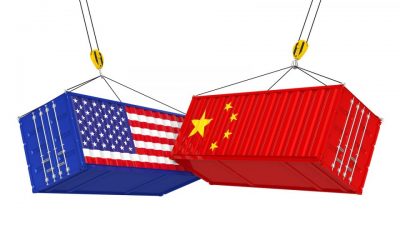Temporary Ceasefire? China and US Agree on Phase One Trade Deal?

According to the Wall Street Journal, China and the US agreed on “roll(ing) back existing tariffs on Chinese goods and cancel(led) new (15%) levies” on another $156 billion worth of its imports scheduled to be imposed on December 15.
The deal involves large-scale Chinese purchases of US agricultural products and “other concessions, according to people familiar with the matter,” the Journal adding:
“(T)he deal calls for China to buy $50 billion worth of agricultural goods in 2020, along with energy and other goods. In exchange the US would reduce the tariff rate on many Chinese imports, which now ranges from 15% to 25%.”
A snapback provision calls for reimposing tariffs if Chinese purchases aren’t fulfilled as agreed on.
According to Bloomberg News, US duties on Chinese imports will be reduced “by as much as half,” ones scheduled for December 15 “delay(ed),” adding:
“(T)here is nothing in this tentative deal that wouldn’t have existed in the absence of the past two years of wrangling.”
China’s phase one “commitments on farm purchases…won’t even be in writing.” The Trump regime accomplished little in trade talks with China over the past two years.
Temporary ceasefire leaves major issues unresolved. China wanted tariffs relief to boost its weakening economy. Trump hopes the phase one deal will help his reelection prospects.
China’s Foreign Ministry spokeswoman Hua Chunying stopped short of agreeing with reports that a phase one trade deal with the US was agreed on by both sides, saying:
“As soon as reports suggesting the phase one deal was reached emerged, the major stock markets in the US and Europe jumped,” adding:
“This illustrates that a deal through negotiation is beneficial to both nations and their peoples, and it is what the international community wants.”
“The agreement has to be mutually beneficial to each other.” On Friday, China’s Foreign Minister Wang Yi said updated information on trade talks would be released shortly.
China’s Global Times editor Hu Xijin tweeted: “Chinese authorities and official media so far haven’t given any information on China and the US are close to a deal.”
“As the US side released optimistic information through various channels, the Chinese side has basically kept silent. This is a delicate situation.”
On Friday, China’s Global Times reported that a phase one deal was agreed on, citing “multiple US media” reports, adding:
“Neither the White House nor the Office of the United States Trade Representative responded to requests for comment on the status of the agreement.”
“China has yet to confirm whether it will push ahead with postponing its own tariffs of between 5 and 10 per cent on US goods, also set to go into effect on Sunday.”
Currently, US tariffs up to 25% exist on about $375 billion worth of Chinese imports, Beijing duties on around $110 billion worth of US products.
According to State Department consultant John Sitilides, a phase one deal “does not halt or even suspend the US-China trade dispute, which is strategic in nature and will continue in ongoing phases for years if not decades so long as Beijing flouts the free, open and rules-based global trading system (sic) that has propelled it to the top ranks of the world economy.”
What Pompeo earlier called “the China challenge” is all about its high-level economic growth and technological advances for decades — compared to US stagnation and decline.
It’s largely a service economy, its manufacturing base hollowed out, millions of its high-pay and other jobs offshored to China and other low-wage countries.
Beijing’s system threatens the US-led Western neoliberal model. Its growth heads the country toward becoming the world’s largest economy in the years ahead, an intolerable notion in Washington.
This threat cuts to the heart of the Trump regime trade war. The US wants China and other countries it doesn’t control transformed into client states.
Beijing won’t let itself be trapped the way other nations subordinated their sovereign rights to US interests.
China’s successful economic model fueled its growth — free from US control, not victimized by its exploitive practices, clearly what it’s not about to sacrifice in dealings with the US now and ahead.
A phase one trade deal belies major irreconcilable differences on major issues.
They’re all about the US side wanting China contained, weakened and isolated politically, economically, financially, technologically and militarily.
China is rising, the US declining because of its arrogance, rage for dominance over other nations at their expense, endless wars on invented enemies, and unwillingness to change.
VISIT MY WEBSITE: stephenlendman.org (Home – Stephen Lendman). Contact at [email protected].
Stephen Lendman is a Research Associate of the Centre for Research on Globalization (CRG)
My newest book as editor and contributor is titled “Flashpoint in Ukraine: How the US Drive for Hegemony Risks WW III.”

